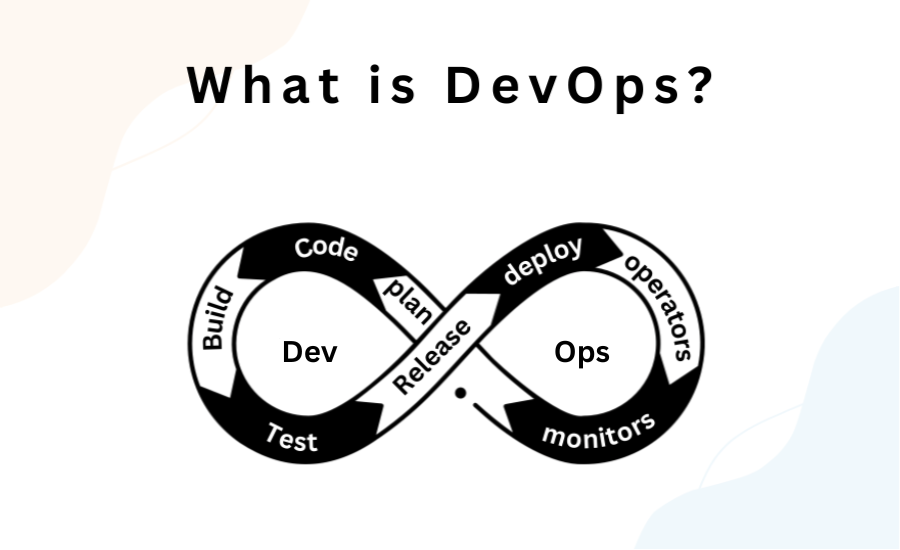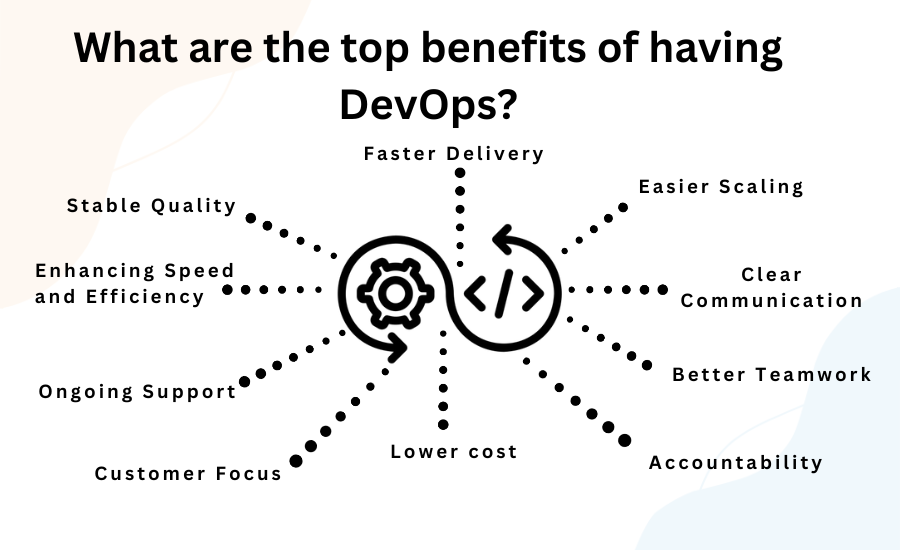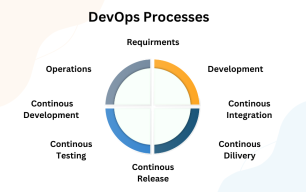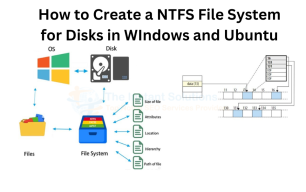What is DevOps? Benefits and Overview

Software development merges code, tools, design, and practices into a unified process focused on delivering applications quickly and efficiently. Whether creating new products or enhancing existing ones, speed is crucial. DevOps addresses this need by fostering collaboration and speeding up high-quality software delivery.
What is DevOps?
DevOps is a combination of cultural values, practices, and tools designed to improve an organization's ability to deliver applications and services at high speed. This approach enables faster product evolution and improvements, allowing organizations to outpace traditional software development and infrastructure management methods. Before DevOps, these teams typically worked independently, resulting in communication barriers and delays. Without it, products are more difficult to maintain, and scaling is not easy. To overcome these challenges, organizations focused on creating high-quality software products rapidly and at scale have adopted this feature. The speed facilitated by it helps businesses better serve their customers and stay competitive in the market.
How DevOps Works?
In a DevOps model, development and operations teams no longer operate in silos. Usually, these two teams combine into a single unit, with engineers taking on responsibility for the full application lifecycle, including development, testing, deployment, and operations. This team gains diverse skills beyond a single function.
In some DevOps models, quality assurance and security teams are also closely integrated throughout the lifecycle. When security is embedded into every part of the process, it’s referred to as DevOps.
DevOps teams automate formerly manual and slow processes. By using a specific technology stack and tools, they enhance speed and reliability, empowering engineers to manage tasks like code deployment and infrastructure provisioning on their own, ultimately boosting team efficiency.
Related topics you may enjoy: DevOps Implementation Plan: A Comprehensive Strategy
Why does DevOps matter?
Software and the Internet have transformed industries globally, impacting the shop, entertainment, and banking industries. DevOps is not just a tool for supporting businesses anymore, it has become an important part of every business function. Businesses now communicate with their clients through software, delivered as online services or applications on different devices. The main goal of DevOps, with its focus on removing barriers between IT operations and development teams, is to deliver customer value faster and more effectively. DevOps aims to improve the speed, quality, and security of business outcomes by enabling more frequent product releases, faster feature updates, and quicker bug fixes. In addition, DevOps emphasizes maintaining smooth, consistent, and scalable underlying infrastructure performance as software is developed, tested, and deployed into production.
Key Benefits of DevOps

Organizations use it for a variety of reasons. Some of the key benefits of DevOps are:
1. Enhancing Speed and Efficiency
DevOps drives innovation, allowing organizations to react more quickly to customer demands, respond to changes in the marketplace, and enhance business efficiency. Microservices and continuous delivery enable teams to own services and deliver updates quickly.
2. Faster Delivery
DevOps accelerates the process of releasing and allows teams to introduce new features and fix bugs faster. Practices like continuous integration and continuous delivery automate the software release process, enhancing speed from build to deployment.
3. Stable Quality
DevOps provides quality across application updates and infrastructure changes. Techniques like continuous delivery and continuous integration allow test changes for functionality and safety while monitoring and logging provide instant feedback on performance.
4. Easier Scaling
The great advantage it has in automation and consistency, enables companies to handle processes and infrastructure at scale effectively. Practices like infrastructure as code make environments repeatable, helping to manage complex or dynamic systems.
5. Better Teamwork
It encourages closer collaboration between developers and operations teams. Shared responsibilities, reduced handoffs, and integrated workflows increase efficiency, saving time and providing higher-quality products.
6. Security
It allows companies to go fast without compromising on security. Automated policy-driven compliance and configuration management practices ensure security and control, even at scale.
7. Clear Communication
It eliminates the need for knowledge transfers between departments. With one team managing the entire lifecycle, they maintain a better idea of development and maintenance, leading to higher quality and fewer defects.
8. Accountability
Decentralized accountability allows teams to innovate and produce according to what they discover from developing the product.
9. Customer Focus
Operations no longer simply "keep the lights on." The DevOps group hears user complaints and makes necessary adjustments or repairs.
10. Lower cost
Reduces risks and costs after deployment. The same team that creates the functionality also handles deployment and post-launch support.
11. Ongoing Support
It also ensures long-term product sustainability, making it work over time.
DevOps is All About CAMS
Just like adopting agile, a shift in mindset is important for successfully implementing DevOps. To ensure the change is effective, it's important to alter your way of thinking and working. A helpful framework to remember during this transformation is CAMS. John Willis and Damon Edwards first introduced this acronym, which represents the principles that drive DevOps:
- Culture: Ultimately, success in DevOps relies on the individuals and processes involved, with everyone working together aligned to support the shared vision.
- Automation: Repeatedly perform the most time-consuming or repetitive tasks automatically on a regular schedule, and make sure all tools work together perfectly in an automated process.
- Measurement: Use objective measurements to determine where the environment is needed, and decide which areas to automate first.
- Sharing: Foster a culture of sharing ideas, insights, and improvements, not only within teams but also across teams.
DevOps Adoption
DevOps is a blend of processes, methodologies, tools, and people aimed at improving collaboration and supporting quicker, more reliable product delivery. The goal of a DevOps setup is to encourage improved documentation, automation, and communication with better collaboration.
DevOps Model Defined
DevOps is a software development process that aims at communication and collaboration between development (Dev) and operations (Ops) teams. The central goal of DevOps is minimizing the software development lifecycle while increasing the quality and reliability of releases.
DevOps Model
1. Delivery Pipeline
The delivery pipeline outlines the software's various stages before reaching production. These stages typically include:
- Build: The stage where the software code is compiled and packaged into a deployable unit.
- Test: The stage where the software undergoes rigorous testing to ensure it functions as expected, with any bugs identified and addressed.
- Release: The stage where the software is deployed to production for end users.
2. Feedback Loop
The feedback loop represents the information gathering and intelligence from the production environment, which is then returned to the initial states of the pipeline. Feedback is crucial to enhancing the software development process and subsequent releases.
DevOps Practices
DevOps practices focus on continuous improvement and automation in several stages of the development cycle. These practices include:
- Continuous Development: Involves planning and coding, which may include version control.
- Continuous Testing: Continuous automated and repeated code testing as application code is created or changed to ensure quality.
- Continuous Integration (CI): It combines configuration management tools with other testing and development tools to measure the proportion of the code ready for production. It offers instant feedback to expedite problem discovery and solving.
- Continuous Delivery: Following testing, code updates are automatically pushed to a pre-production or staging environment, optionally with manual promotion to production.
- Continuous Deployment (CD): Code updates are pushed to production environments automatically, frequently several times a day. Continuous deployment is supported by container technologies like Docker and Kubernetes, as they ensure code consistency across environments.
- Continuous Monitoring: Ongoing monitoring of both application code and the supporting infrastructure. It creates a feedback loop to inform the development of bugs and issues in production.
- Infrastructure as Code (IaC): Developers use code to automate infrastructure provisioning and configuration. It allows for easier monitoring of environment configurations and simplifying rollbacks.
Summary
DevOps is not just a collection of tools and practices; it’s a mindset that promotes collaboration, efficiency, and ongoing improvement. For developers, adopting it brings numerous advantages, including enhanced teamwork, quicker time-to-market, higher software quality, and opportunities for skill diversification. By embracing these principles, developers are empowered to engage with the entire software lifecycle from design and development to deployment and monitoring. As the software industry continues to evolve, adopting this approach becomes increasingly crucial for developers aiming to deliver high-quality software quickly and reliably.



